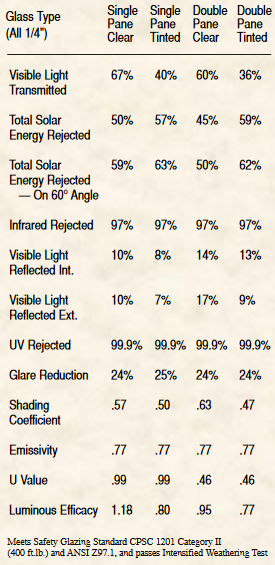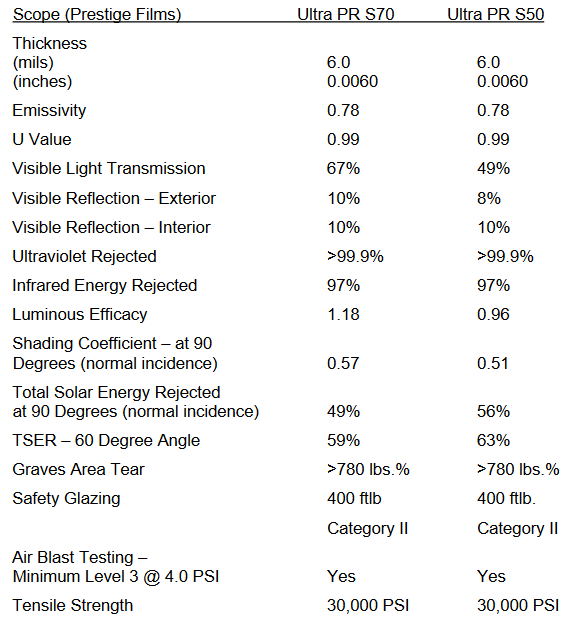Prestige S70 – Safety and Security Window Film
A film that combines 3M’s most sophisticated window film technologies: nano and multi-layered. This film is ideal for sun control and security (fragment retention, hurricane protection, and combating smash and grab crime). This is the security film version of Prestige 70. This is the lightest version with a 70% light transmission.
Prestige S70 Safety and Security Window Film – Benefits:
- 3M patented technology utilizes many micro layers in a 6 mil film to provide enormous strength and tear resistance compared to standard PET films
- Improves personal, property and asset protection from hurricanes, blasts and earthquakes
- Substantial heat rejection provides energy savings and enhanced comfort, combined with a modestly tinted film
- Increased on-angle heat rejection provides additional performance benefits
- Low reflection enhances views and overall beauty
- No metals; 3M technology provides superior performance with no corrosion or interference with cell phone signals
- Extends the life of furnishings by rejecting UV rays, the single largest component of fading
- Premium 3M manufacturer’s warranty
Prestige S70 – Ultra Series – Safety and Security Window Film
Prestige S50 – Safety and Security Window Film – Performance Results:
Visible Light Transmitted – 67%
Total Solar Energy Rejected – -50%
TSER—On 60°Angle – 59%
Infrared Rejected – 97%
Visible Light Reflected Int. – 10%
Visible Light Reflected Ext. – 10%
UV Rejected – 99.9%
Glare Reduction – 24%
Luminous Efficacy – 1.18

08 87 53 –ULTRA PRESTIGE SECURITY FILM
PART 1 – GENERAL
1.1 SUMMARY
A. Section Includes:
1. Shatter resistant, IR-rejecting, solar control, clear window films designed to be applied to interior window surfaces to hold broken glass together and reduce solar heat and ultra-violet light.
1.2 SYSTEM DESCRIPTION
A. Performance Requirements:
1. 3M Prestige Safety and Security Window Film. The following performance information is based on 1/4 inch (6 mm) clear glass unless indicated otherwise:

B. Film Attributes: The following attribute information is based upon 1/4 inch (6 mm) clear glass unless indicated otherwise:
1. Emissivity: Emissivity of non-adhesive surface of film shall be 0.78 nominal when measured using Devices & Services Emissometer Model AE at or near room temperature. Provide laboratory data of emissivity and calculated window “U” Values for various outdoor temperatures based upon established calculation procedure defined by the 1997 ASHRAE Handbook of Fundamentals, Ch. 29, or Lawrence Berkeley Laboratory Window 5.2 Computer Program.
2. U Value: 0.99 nominal when measured per test procedures described in Emissivity paragraph.
3. Visible Transmission: 66 percent nominal when measured with integrating sphere spectrophotometer, ASTM E-903, and calculated per ASTM E-308 using Standard Source “C” for average daylight.
4. Visible Reflection, Exterior: 10 percent nominal total luminous reflection from glass surface when measured with an integrating sphere spectrophotometer as referenced by ASTM E-903 and calculated per ASTM E-308 using Standard CIE Source “C” for average daylight.
5. Visible Reflection, Interior: 9 percent nominal total luminous reflection from film surface when measured with an integrating sphere spectrophotometer, ASTM E-903, and calculated per ASTM E308 using Standard CIE Source “C” for average daylight.
6. Ultraviolet Light Transmission: 0.1 percent total transmission of solar ultraviolet radiation of air mass equals 1.5 over spectral range of 3000 to 3800 angstroms when measured with an integrating sphere spectrophotometer, ASTM E903.
7. Infrared Energy – Rejected: Not greater than 3 percent IR transmission when measured between 900 and 1000 nanometers.
8. Luminous Efficacy: 1.16 nominal (defined as ratio of visible light to shading coefficient).
9. Shading Coefficient: 0.57 nominal, 0.50 at 60 degrees F (15.5 degrees C), measured per ASTM E903 and computed per established procedures defined by The 1997 ASHRAE Handbook of Fundamentals.
10. Total Solar Energy Rejected – Normal and 60 Degree Angle: 49 percent nominal, 59 percent at 60 degrees F (15.5 degrees C), measured per ASTM E903 and computed per established procedures defined by The 1997 ASHRAE Handbook of Fundamentals.
11. Adhesive System: High mass, optically clear, pressure sensitive, weatherable, acrylate adhesive applied uniformly over surface opposite abrasion resistant coated surface.
12. Flammability: Class A Interior Finish for Building Materials for both Flame Spread Index and Smoked Development Values per ASTM E-84.
13. Abrasion Resistance: Surface coating resistant to abrasion, with less than 5 percent increase of transmitted light haze will resulting per ASTM D1044 using 100 cycles, 500 grams weight, andCS10F Calbrase Wheel.
14. Tear Resistance: Minimum tear resistance value of 780 pounds by x percent) when measured per ASTM D1004 (Graves Area Tear Test) at 20 inches per minute (508 mm per minute).
15. Safety Glazing: The film, when applied to either side of window glass, shall pass a 400 foot-pound impact when tested per CPSC CFR16, Part 1201 Category II and shall pass accelerated weathering test requirements for both tensile strength and peel strength.
16. Large Scale Explosive Blast Testing: The film, when applied to glass, shall meet a minimum performance level of 3b (or better) when open-air blast tested to a minimum of 4.0 PSI with 28/msp
peak-over pressure and tested per GSA Test Standard Protocols, which is an adaptation of ASTM F1642-96.
17. Tensile Strength: Average tensile strength of 30 kpsi when tested per ASTM D882-95a.
18. Young’s Modulus (PSI): Nominal Young’s Modulus of 500 kpsi when tested per ASTM D-882-95a.
19. PPT (Puncture Propagation Tear): Average PPT value of 7.5 pounds when tested per ASTM D-2582-93.
20. Elongation: Average elongation of 130 percent when tested per ASTM D-882-95a.
21. Break Strength (per 1 inch width): Average break strength of 120 pounds per mil of film thickness.
1.3 DELIVERY, STORAGE, AND HANDLING
A. Manufacturer will ensure proper quality control during production, shipping, and inventory, clearly identify and label each film core with product designation and run number.
B. Deliver materials to project site with manufacturer’s labels intact and legible.
1.4 QUALITY ASSURANCE
A. Dealer and Applicator Qualifications: Provide documentation that dealer and applicator are authorized by manufacturer of window film to install window films.
1. Provide reference list of 10 projects of similar size on which applicator has installed window films. Include on the following:
a. Name of buildings.
b. Name and telephone numbers of management contacts.
c. Types of glass.
d. Types of film.
e. Amount of film installed.
f. Dates of completion.
2. Upon request, provide Glass Stress Analysis of existing glass and proposed glass/film combination as recommended by film manufacturer.
3. Upon request, provide application analysis to determine available energy cost reduction and savings.
1.5 WARRANTY
A. Warrant materials and workmanship for 15 years against defects after completion and final acceptance of Work.
1. Repair defects from faulty materials or workmanship developed during guarantee period, or replace with new materials, at no cost to Owner.
2. Warranty covers the following:
a. Film will maintain solar reflective properties without cracking, crazing, delaminating, peeling, or discoloration.
b. Glass failure due to thermal shock fracture of glass (maximum value of $500.00 per window) provided film is applied to recommend types of glass and failure occurs within 60 months from start of application. Glass failures shall be reviewed by film manufacturer prior toreplacement.
PART 2 – PRODUCTS
2.1 MANUFACTURER
A. Subject to compliance with requirements, provide projects from the following manufacturer:
1. 3M Company
2. Distributed through: GlassEnergy
4. Point of Contact: Rob Versa, 1-877-684-4040, info@glassenergy.com
2.2 MATERIALS
A. Film Material: Film material consists of an optically clear, micro-layered, polyester film laminated to different clear multi-layered polyester film containing at least 220 layers with an acrylic pressure sensitive adhesive on 1 side and durable acrylic abrasion resistant coating on the other side. Films contain no metals, but so contain infrared-absorbing carbon, metal oxide particles, or both.
1. Film Color: Clear, containing no metal coatings or dyed polyesters.
2. Provide uniform film, without noticeable pin holes, streaks, thin spots, scratches, banding, or other optical defects. Variation in total transmission across width, at any portion along length, shall not exceed 2 percent over average. Provide film with no evidence of coating voids.
3. Film Thickness: Nominal thickness of 6.0 mils (0.006 inches).
SPECIFIER NOTE: RETAIN APPROPRIATE FILM TYPE IN SUBPARAGRAPH BELOW. DELETE FILM TYPE NOT REQUIRED.
B. Acceptable Products: Safety and Security Films, 3MTM Ultra Prestige Safety and Security Window Film.
1. Prestige Films Ultra PR S50.
2. Prestige Films Ultra PR S70.
PART 3 – EXECUTION
3.1 EXAMINATION
SPECIFIER NOTE: RETAIN APPROPRIATE PROJECT OPTION IN PARAGRAPH BELOW. DELETE OPTION NOT REQUIRED FOR PROJECT.
A. Examine glass surfaces to receive film and verify that they are free from defects and imperfection, which will affect final appearance. Correct and note such deficiencies to [Owner] [Architect] prior to commencing film application.
3.2 PREPARATION
A. Use protective tarps and drop cloths to cover interior finishes near window.
B. Clean window and window framing thoroughly with neutral cleaning solution. Blade inside surface of window glass with industrial razors to insure removal of foreign contaminants.
C. Place towel or other absorbent material on widow sill or sash to absorb moisture accumulation generated by film application.
3.3 INSTALLATION
A. Install window films per manufacturer’s written instructions.
1. Cut film edges neatly and square at a uniform distance of 1/8 inch (3 mm) to 1/16 inch (1.5 mm) from window sealant.
2. Edge Seal (to protect from edge corrosion) – None required. 3M Ultra Prestige Window Films do not contain metals.
3. Use water and film slip solution on window glass and adhesive to facilitate proper positioning of film.
4. Use polyplastic bladed squeegees to insure efficient removal of excess water from underside of film and to maximize bonding of pressure sensitive adhesive.
5. Upon completion of film application, allow 30 days for moisture from film installation to dry thoroughly, and to allow film to dry flat with no moisture dimples when viewed under normal viewing conditions.
3.4 CLEANING
A. After application of film, wash film using common window cleaning solutions, including ammonia solutions, 30 days after application. Do not use abrasive type cleaning agents and bristle brushes to avoid scratching film. Use synthetic sponges or soft clorths.
B. After installation, remove left over material and debris from Work area. Use necessary means to protect film before, during, and after installation.